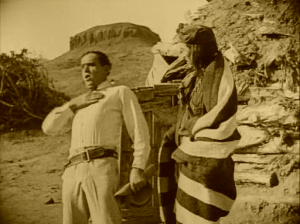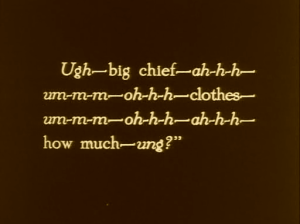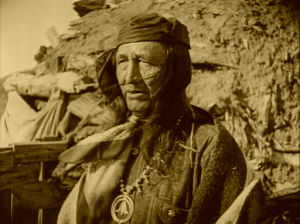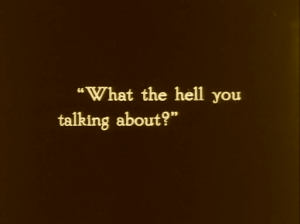The title card is from Victor Fleming’s HULA, a Hawaiian-set Clara Bow vehicle from 1927, and the chin referred to comprises a principle part of the facial apparatus of leading man Clive Brook. The card cracked me up because of the scene described by Maria Riva in her slyly vengeful biography of her mother, Marlene Dietrich.
SHANGHAI EXPRESS is in prep. Von Sternberg has selected Brook, whom he knew well and had directed in UNDERWORLD, a major hit, as Frau Dietrich’s leading man. “What’s he like?” she asked.
“He’s a chin.” said Jo.
Brook, who comes across as something of a stick in SHANGHAI EXPRESS, is actually human and sympathetic in UNDERWORLD, which is rather hard to see nowadays (do I hear rumours of a Criterion DVD? Snap it up!) and his stiffness is used as an appealing quality in HULA, proving that he could be effective onscreen, or at least more so than he is opposite Dietrich.
Listen — some kind of strange dynamic is at work in the Sternberg choice of leading men: one time he’ll give her Gary Cooper — what Stanwyck would call a real yum-yum type — next, she gets Victor McLaglen. “Why is he grinning like that?” my students asked. “He’s Victor McLaglan — that’s what he does!” was all I could offer as explanation. Then wooden Clive and his balsa chin, then the pendulum swings back, offering not only Herbert Marshall but a side order of Cary Grant. Then John Lodge, about whom I can’t quite decide, then the astounding double feature of Lionel “Pinky” Atwill and Cesar “Butch” Romero. It’s like a succession of hot and cold baths.
In HULA, Brook’s pairing with Bow could have been disastrous, since she has the legendary “it” and all he has is “that” — humanity’s first fully opposable chin. But since she’s so young and vivacious and he’s so Clive Brook, actually what he gets out of the partnership is vulnerability. She can dance rings around him, and you feel for him as a result.
It was a good time to see the film, as Victor Fleming had been on my mind — Philip French wrote a good piece in The Observer recently (a relief: French is extraordinarily erudite, yet The Observer normally have him writing lists of “best hedgehog movies” or whatever), I caught a bit of THE WIZARD OF OZ again during it’s seasonal TV run, and I grabbed a copy of WHEN THE CLOUDS ROLL BY, recently acclaimed on David Bordwell’s excellent site.
A bit of business borrowed by RAIDERS OF THE LOST ARK.
HULA isn’t any masterpiece, but we get primo cuteness from Bow, including a nude swim for starters (was any actress of the age so frequently unclad?) and plenty of local colour. The seeds are planted for the campy delirium tremens of CALL HER SAVAGE a few years later.
More interesting yet, and another good use of Brook, was THE MAN FROM YESTERDAY, directed by my old pal Berthold Viertel, whose work I’ve admired consistently. There’s always more imagination and emotional sensitivity in his work than you’re expecting. This one sees BV in Hollywood, where his son Peter would enjoy a longer career, directing a Paramount romantic tragedy where Brook plays a WWI soldier who marries Claudette Colbert during an air raid, impregnates her in the back of a cab in the Bois du Boulogne, and then gets gassed in the trenches. “Killing ‘im with stuff that smells like flowers,” muses a passing cockney stereotype.
But Brook is not dead, just reported as such. Colbert takes up with suave doctor Charles Boyer, but can’t quite bring herself to marry him. Good pre-code banter as she checks into a Swiss hotel with her lover. He asks for a double room, she gently corrects him, asking for two singles. “Adjoining,” he specifies, in that endearing Gallic way of his.
Brooks is resting up in this same hotel, his lungs still raddled. His best buddy Andy Devine has been caring for him. (Devine is great here, although he makes a very unlikely Brooklynite, to my ears.) Brooks doesn’t want to reveal himself to Colbert, but Boyer learns the truth and nobly absents himself from the picture. Now Colbert tries to make a home for Brooks with his son (a terrific, cute-as-a-button kid called Ronnie Cosby), but he is, as the title has told us… THE MAN FROM YESTERDAY.
Viertel had a gift for taking sentimental stuff like this, or LITTLE FRIEND, and giving it a bit of life, and he’s aided greatly by Karl Struss’s cinematography. The film doesn’t have LITTLE FRIEND’s fervent experimentalism nor the allegorical intensity of THE PASSING OF THE THIRD FLOOR BACK, but the performances and story are well handled, the appeals to emotion are discrete, and there are strange and unsettling moments, as when Brook drunkenly hallucinates Colbert’s face on top of a floozy’s, and the voice of one issues from the lips of the other — and this ECU of a black singer’s mouth, which seems to have some odd significance as memento mori…
Soon I want to talk about Viertel’s last film, RHODES OF AFRICA, a more problematic case but an interesting one…









